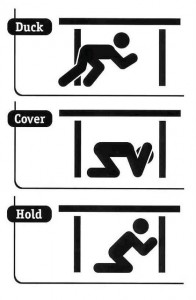Ocean Companies Safety Tip of the Week – Earthquakes
What To Do When an Earthquake Hits
Last week I was fortunate enough to attend a table top exercise, or a “what happens if” on a major earthquake hitting the South Beach area of Grays Harbor, Washington and I learned a lot. The exercise was put on by our LEPC, or Local Emergency Planning Committee and was attended by many fire departments, ambulance personnel, elected officials, city employees, local business representatives and private citizens.
 During an earthquake, remember to DROP, COVER AND HOLD ON. Drop to the ground, get under a table, desk or anything that will save you from the debris falling from the ceiling, and hang on to the legs of whatever you are under until it stops shaking. If there is nothing for you to crawl under, drop to the ground, cover your face and head with your arms, and crouch in an inside corner of the building. Stay away from anything glass, outside doors or walls, and anything that could fall, such as light fixtures. Do not run to another room or use a doorway. If you are outside when things start shaking, move away from buildings, streetlights, and utility wires. If you are driving, stop as soon as it is safe and stay inside your vehicle. When things calm down, get out of the building as safely as possible or where ever you were when the earthquake hit, move to high ground and stay there until someone of authority (e.g. a policeman, fireman, city employee, etc.) tells you it’s safe to leave.
During an earthquake, remember to DROP, COVER AND HOLD ON. Drop to the ground, get under a table, desk or anything that will save you from the debris falling from the ceiling, and hang on to the legs of whatever you are under until it stops shaking. If there is nothing for you to crawl under, drop to the ground, cover your face and head with your arms, and crouch in an inside corner of the building. Stay away from anything glass, outside doors or walls, and anything that could fall, such as light fixtures. Do not run to another room or use a doorway. If you are outside when things start shaking, move away from buildings, streetlights, and utility wires. If you are driving, stop as soon as it is safe and stay inside your vehicle. When things calm down, get out of the building as safely as possible or where ever you were when the earthquake hit, move to high ground and stay there until someone of authority (e.g. a policeman, fireman, city employee, etc.) tells you it’s safe to leave.
 Have you ever heard the word liquefaction? According to Dictionary.com it is “the act or process of liquefying or making liquid” or “the state of being liquefied.” When the ground shakes, sand come up through the cracks and gravel in a seemingly liquid movement creating a mess on the roads that sometimes brings traffic to a stop. This was a major factor in Christchurch, New Zealand on February 22, 2011 and Japan on March 11, 2011. Between liquefaction and road/bridge damage, it could be near impossible to get out of town. If we are hit by a large earthquake in any of the surrounding areas, we may be stuck here for days before help from outside the area could arrive.
Have you ever heard the word liquefaction? According to Dictionary.com it is “the act or process of liquefying or making liquid” or “the state of being liquefied.” When the ground shakes, sand come up through the cracks and gravel in a seemingly liquid movement creating a mess on the roads that sometimes brings traffic to a stop. This was a major factor in Christchurch, New Zealand on February 22, 2011 and Japan on March 11, 2011. Between liquefaction and road/bridge damage, it could be near impossible to get out of town. If we are hit by a large earthquake in any of the surrounding areas, we may be stuck here for days before help from outside the area could arrive.
The most important thing you can do for your family is to develop a “Family Plan for Disasters”. Write it down and go over it with your family, kids included! February 28, 2012 marked the eleventh anniversary of the 6.5 magnitude Nisqually Earthquake that shook Western Washington, caused over 2 billion dollars in damages, and injured over 400 people from Seattle to Grays Harbor County. In honor of this anniversary, Grays Harbor Emergency Management sent out the following list of things your plan should include:
- Have a contact number for a friend or relative living in another state. There is a real possibility that phones may be out for the whole state, Eastern as well as Western, if we are hit hard.
- How will your family communicate with each other if separated? One idea may be leaving a note inside the front door and/or one at a community gathering spot. Go to those places and have your family members actually touch where they may leave a note so they will be familiar with the location of where the note will be.
- Does your child’s school have a disaster plan and do you know what they’ll do?
- Does your employer have a disaster plan?
- Have a “Go Kit” for each family member and each pet. Each kit should be contained in a waterproof backpack.
1. For people: 2 bottles of water, 2 energy bars, pocket sized rain parka, pocket sized emergency blanket, flashlight, small am/fm radio, jacket or sweatshirt with hood, laminated copy of prescriptions, small pack of sanitary wipes, hand sanitizer, band aids, gauze, medical tape, and laminated copy of emergency contact numbers and addresses of friends and family (in another state if possible)
2. For pets: 2 bottles of water, towel, pocket sized emergency blanket, 2 pet food meals in disposable pouches or cans, pet leash and or harness, laminated copy of most recent vaccination record for each pet.
- Have copies of important papers in one spot, e.g. birth certificates, mortgage papers, credit card numbers, prescriptions, phone numbers of family and friends (in another state if possible). Place these in waterproof containers and if possible, send copies to an out of state friend or relative for safe keeping.
- Have some cash in small bills to purchase needed items. Remember, without power, ATMs, debit and credit cards will do you no good.
- Take the time to call your insurance provider before the impact of a natural disaster. Make sure of the things you are covered for, but mostly for what is not covered by your policy.
- Find out about your county’s notification system and how to sign up for it. If you live in or near Grays Harbor, you can sign up for the Grays Harbor County Notification System by clicking here and filling out the form.
- Obtain an “All Hazards Weather Radio”.
- Know all your surrounding neighbors.
- If you have a medical problem, make sure your local ambulance service knows about it.
- Teach your children EVERYTHING!!
There is so much more to know and it might be a good thing for you and your family to look into what to do to prepare for emergencies. But if you don’t do anything more than just get your plan together, you’ll already be ahead of where you are right now. Think, plan, do!
Sources: Grays Harbor County Department of Emergency Management, ShakeOut.org
– Cherie


